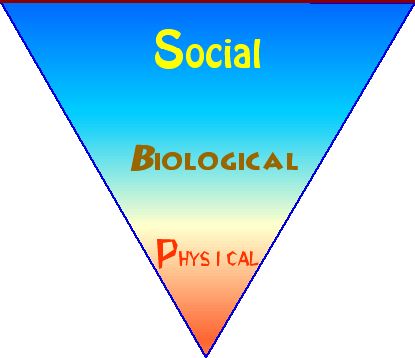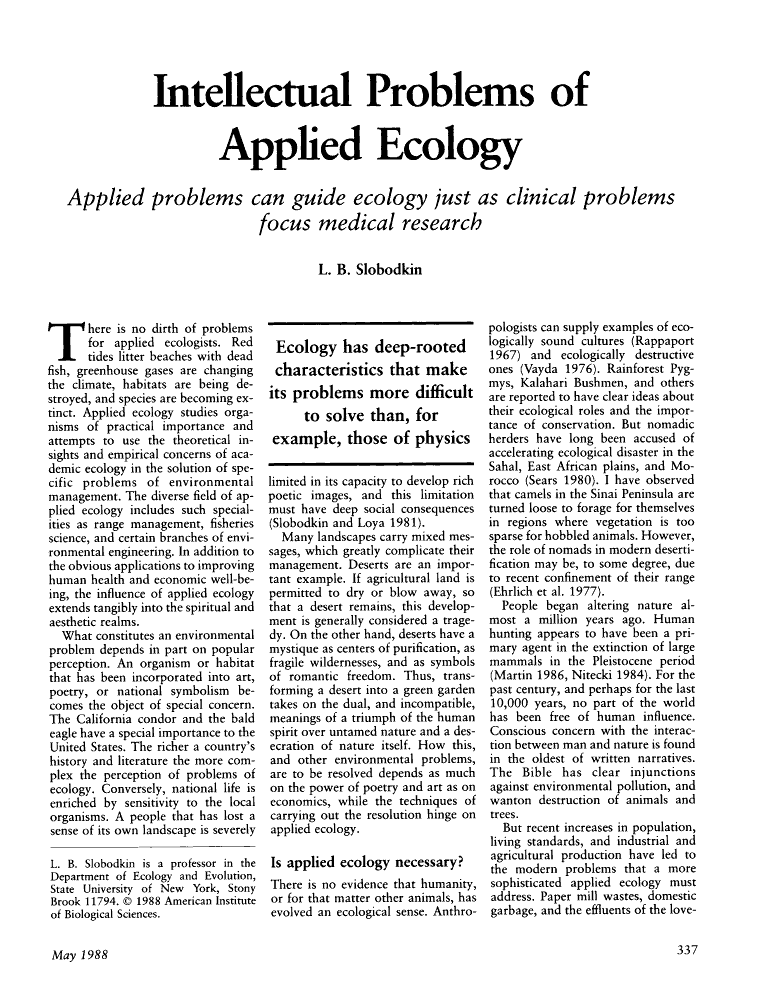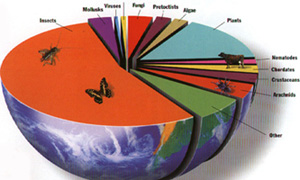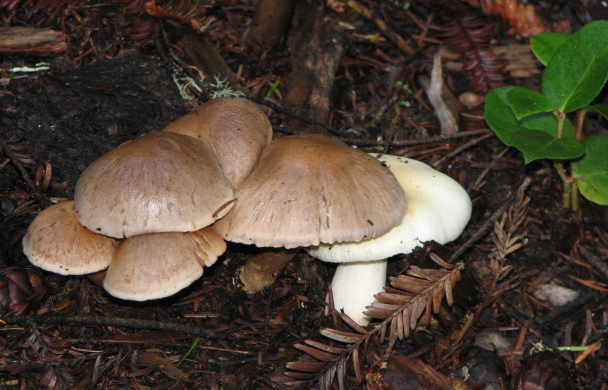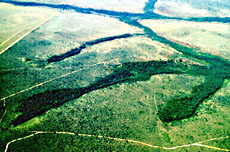 Problem
solving
Problem
solvingNavigating the site:
Ecological problem solving involves an ecological imagination in order to envision the hidden relations binding all creatures to one another in the places they are inhabiting.
Consider recent findings:
James A. Estes, et. al. "Trophic Downgrading of Planet Earth" Science, 15 July 2011.
"Until recently, large apex consumers were ubiquitous across the globe and had been for millions of years. The loss of these animals may be humankind’s most pervasive influence on nature. Although such losses are widely viewed as an ethical and aesthetic problem, recent research reveals extensive cascading effects of their disappearance in marine, terrestrial, and freshwater ecosystems worldwide. This empirical work supports long-standing theory about the role of top-down forcing in ecosystems but also highlights the unanticipated impacts of trophic cascades on processes as diverse as the dynamics of disease, wildfire, carbon sequestration, invasive species, and biogeochemical cycles. These findings emphasize the urgent need for interdisciplinary research to forecast the effects of trophic downgrading on process, function, and resilience in global ecosystems.
Science, 15 July 2011:
Vol. 333 no. 6040 pp. 301-306
DOI: 10.1126/science.1205106
- large apex consumers– top level predators: such as polar bears, cougars, lions, etc.
- ubiquitous– everywhere.
- cascading effects– when one thing is dependent on the other; failure of both ensues.
- trophic cascades– the food chain nourishes fewer creatures, specialists die-off.
- trophic downgrading– controls exhibited by large consumers at the top of the chain are gone.
- process– the conversion of energy and nutrients into food, shelter, and dependencies.
- function– the role of population control that predators exhibit on grazers or prey numbers.
- resilience– the assimilative and carrying capacity of places to recover from damage.
- ecological terminology & ecology index.
- laws of ecology.
Problems | Natural power source's | Cycles | Forestry | Biodiversity | Climate | Ecological Integrity | Assets | Accounting
"There is no evidence humanity,...has evolved an ecological sense.
"People began altering nature almost a million years ago."
An older case study of Estes & Slobodkin's points:
Consider what biologist, Norman Myers says about tropical forests, trees, fungi, soil and climate.
page 202
“the richest and most complex ecosystems on earth,...as well as the oldest, of them all.”
¶ 2
“On looking back, I feel that the forest represented a more striking spectacle than any other I have come across during my travels in almost one hundred countries....a dipterocarp forest is in a class of its own.” ¶ 3
page 203
“Things will not be the same for you again after setting eyes on something that exceeds all your previous experience.”
“An above average dipterocarp,...can measure 5 meters (15 feet) around” ¶ 4“Still more important, it was the entire community of dipterocarps that impressed me, so many of these giants towering in one area.
400-700 trees per hectare [2.47 acres] these huge plants extending across Borneo for 1,000 kilometers, a greater quantity of impressive trees than anywhere else. Moreover, as a tree is more than just wood, so a forest is more than just trees. ¶ 5
page 204
“A typical dipterocarp soars 50 meters, making it as tall as a twenty story building” -- 50 to 100 ton trees! (Giant Sequoia is 1,000 tons) dipterocarp forests of southeast Asia cover an area of a “million square kilometers.” ¶ 7
“they are an expression of plant life in a league of their own.” 100-600 years old ¶ 8
page 205
“a tropical rain forest amounts to a veritable dynamo for generating wood” ¶ 9
400 cubic meters [cu. m.] / hectare to 600 cu. m. / hectare up to 750 cu. m. / hectare
1 cubic meter ~ one ton (carbon, nitrogen and sulfur fixation)in half a hectare there were 20 species of trees ¶ 10
tree = any thing with a trunk of 4” or 10 centimeters ¶ 10
Chart from ¶ 11’s data:
| Places | extent | species, Native |
| Britain | half hectare | 3-4 (6-8) 35 |
| Appalachia | hectare | 25 50 |
| Indonesia | hectare | 100-200; 2,500 bamboo, 20 meters in height |
¶ 11
page 206
non-woody plants ¶ 12
epiphytes, including 1/4 of all the world's orchids are in Southeast Asia ¶ 13
lack of sunlight for thick undergrowth ¶ 14
canopy "So diverse is the world of the forest canopy that it can be considered the last great frontier of biology ¶ 15
relative ignorance of the biology of the forest canopy “recent advances in frontier biology” ¶ 16
diversity so great that “only a few representatives in a whole hectare.” ¶ 17
page 208
disappearance in the wild of the Malay begonia found only in 1940s ¶ 17
Corcovado NP, Costa Rica, 8 species of Heliconius butterflies ¶ 18
6 million square kilometers of the Amazon region ¶ 18
262 dipterocarp species in Borneo & only 15 in New Guinea; 1700 km eastward ¶ 19
Borneo, or Kalimantan as the Indonesians call it, has a greater diversity of dipterocarp species than does New Guinea, a very diverse island.
“Amazonia has eight phytogeographic zones, or ‘plant areas,’ each with a distinctive assembly of plants and animals. This diversity [ecological] of formations in tropical forests is in contrast to the pattern of forests elsewhere. In Alaska, for example, we find a type of forest that is virtually identical to the one in northeastern Canada -- 4,500 kilometers away.” ¶ 19
what makes a forest tick? ¶ 20
temperate strategies for timbering, parks and preservation must all be different ¶ 20
“I believe that using the term ‘forest’ for a bunch of trees in the tropics and a bunch of trees elsewhere is misleading.” ¶ 20page 209
Borneo receives 5 meters of rainfall... throughout the year. [ 180 inches/ year. ]
Impact of the rain storm on the forest & 1/4 reaches the ground ¶21
“This insulation of the forest interior, I surmised, must help to maintain the equable climate, with its stable warmth and moisture levels throughout the day and night.” ¶ 22
“Following the thunderstorm, the forest released a smell of earthly fertility. A musty odor, like that in a greenhouse, it was strangely satisfying even though it spoke of decomposition" [mixed metaphor?]
“a forest is home to hosts of decomposers, notably organisms of the topsoil, such as mites, nematodes, ants, and termites. In one square meter of leaf litter... found 800 ants belonging to 50 species, while similar square meter may contain as many as 2,000 termites. ¶ 23
page 210.
between 4 and 7 grams of soil fauna per square meter, an amount twice the like weight of all mammals and birds in the region put together. 1/3 to 1/2 termites
¶23
In Malaysia, half the biomass (living matter) of the 4 million wildebeest, zebra and gazelles of the Serengeti is made up of termites!
¶ 23
Ecological integrity, protection
KEY: “the topsoil contains multitudes of fungi, especially mycorrhizal fungi,” ¶24
“In other words the smell of the fungi and other decomposers is the smell of life.” ¶ 24
“In fact, leaf litter can decompose within six weeks” compared to leaf litter decay rates one year in a temperate and 7 years in a boreal conifer forest. ¶ 25
contrast the danger / safety of the forest and the city’s streets ¶ 26
“we still know next to nothing about what makes a forest continue on its quiet, complex way.” ¶ 27
page 211.
“we do not have a precise idea of just how much tropical forest still exists.” ¶ 27
"sensing I had picked up more basic biology in this patch of forest than possible during a day in any other ecological zone.” ¶ 28one of the few ways that really matter, through first-hand experience.... and through a process of ‘imaginative osmosis’ that I find stirs within me whenever I am confronted with a major phenomenon of nature.” ¶ 28
“rather it is recreation in the sense of re-creation.” ¶ 28
Natural Capital | Accounting for natural assets | Worth of ecosystem services
Threats to forests worldwide also come from:
Melissa Walker, Reading the Environment, "Nature's Powerhouse," pages 202 - 210.
Plant ecologist, Dr. Jack Putz of U of Florida, says now this dipterocarp forest has largely disappeared due to logging of older trees.
Personal Communication, 2004.
Science Index | Social Analysis | Population Index | Global Warming Index | Nature Index | Ecological ideas

.gif)
